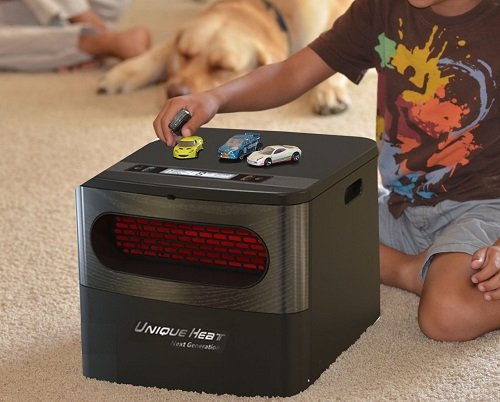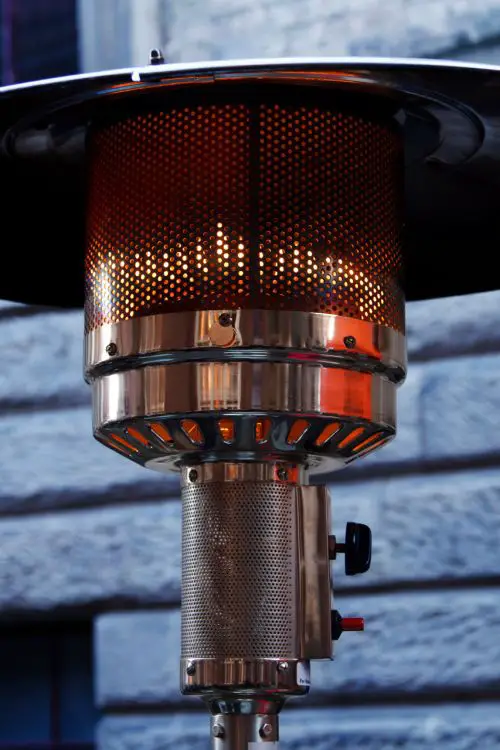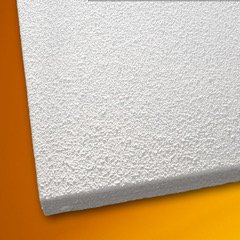In this article, I will discuss the differences between gas-fired heating systems and electric infrared heaters. Some (outdoor) infrared heaters do use gas as a fuel and are similar to gas heaters in almost all aspects. When talking about infrared heaters, I am talking about electric infrared heaters that do not burn any type of fuel.
In this article I will discuss the following topics:
- energy use
- efficiency
- running costs
- type of heat produced
- health and safety
- effects on indoor air quality
- applicability per room
- infrared as stand-alone, whole-house heating
Infrared vs gas heating: energy use
Infared and gas-based heaters differ widely in the way they provide heat. Therefore, it is not very useful to just look at their use. To look at the difference in energy use between infrared heating and gas-fired heating, we need to take a look at what we really want out of our heater.
The most important thing to realize about heaters is that they all convert all their energy use into heat. Gas heaters convert 100% of their energy use into warm air, while infrared heaters are designed to produce infrared radiation. They produce approximately 90% infrared and 10% warm air.
Infrared heaters only heat objects and people that are in range of the infrared rays. In this way, they can be focused on a certain area and provide all their heat in that spot. Therefore, no energy is used to heat areas that are not required to be heated. A gas heater produces warm air and will always heat every nook and cranny of the house. Since warm air rises, a lot of energy goes to waste in heating the air at the ceiling.
Because of this major difference, infrared heaters use much less energy than gas heaters to provide the same amount of comfort.
The following table shows the energy use required per room to get it comfortable. It shows the required wattage per square foot (0,1 m²).Area Infrared heating: wattage
per sq. ft (0,1 m²)Regular heating: wattage
per sq. ft (0,1 m²)Living room 7 W 10 W Bedroom 4.5 W 6.3 W Bathroom 9.3 W 13.3 W Closed porch 9.3 W 13.3 W Open outdoor area 28 – 56 W Warm air cannot heat an outdoor area
You can read all about infrared heaters energy use and how it compares to gas heating in my article: Infrared heaters energy use (costs, efficiency, W/sq. ft.)
Efficiency of infrared vs gas heating
Like any heater, Infrared and gas-based heaters are 100% efficient in producing heat from their energy use. However, infrared produces 90% infrared radiation that heats you and objects directly. The other 10% is warm air. Gas heaters produce 100% warm air.
Since both heaters are 100% efficient in producing heat, it is more useful to look at their effectiveness in fulfilling their desired purpose.
Before infrared heaters, the only option was to heat the entire room or house with warm air. There would be many energy losses because of heating unwanted areas, and high ceilings that you do not necessarily want to be heated. On top of that, drafts and poor insulation result in the loss of warm air.

Infrared heaters provide another type of heating
Infrared heaters provide targeted heat directly at the desired objects and people. Since the infrared rays do not heat the air, much less energy is required for the same level of comfort. Therefore, infrared heaters use approximately 60% less energy than gas heaters.
Although this sounds like an easy choice for infrared, both types of heaters use a different fuel (electricity vs gas), and the prices vary greatly. Therefore, the running costs of both heaters are a better comparison if your main goal is to heat cheaply.
The running costs of gas vs infrared
Even though the energy use of infrared heaters is much lower than that of gas-fired heaters, the energy price differs significantly. Unfortunately, electricity is so much more expensive than gas that the gas-fired heater easily comes out on top while using much more energy.
These are the average prices of energy in the US:
- Average US price of electricity: 13.31 cents ($) per kWh
- Average US price of gas: 3.8 cents ($) per kWh
The following table shows the running costs of infrared heating vs gas based heating.Time costs infrared ($) costs gas ($) One hour 30.6 cents 12.5 cents Day (6 hours) 1 dollar and 84 cents 75 cents Week 12 dollars and 86 cents 5 dollar and 27 cents Month (30 days) 55.1 dollars 22 dollars and 57 cents
This table assumes an average 330 square foot US living room that has medium insulation. The required amount of energy for infrared heating for this room is 2300 watts. The required amount of energy from gas is 3300 watts.
I wrote an article on the running costs of infrared vs gas-based heating that shows the basic calculation for an average-sized living room. You can find it here: The real running costs of infrared heating (compared to gas).
Health and safety: gas vs infrared heating
Infrared heaters are much safer than gas-based heaters. They do not burn any fuel and therefore do not pose risks related to the burning of fuel such as:
- air pollutants release
- Carbon monoxide release
- Gas leaks
- Fire hazard
Carbon monoxide (CO)
Carbon monoxide (CO) is a colorless and odorless gas that can be very dangerous. Exposure to high concentrations of CO can have significant health effects such as headaches, unconsciousness, and even death. For more information about carbon monoxide, I recommend my article: Do infrared heaters emit carbon monoxide? (different heaters, CO prevention).
Heating causes air pollution
Heaters can lead to poor indoor air quality in more than one way. They can release air pollutants from the heater itself or have an indirect effect on your air quality by increasing air movement due to rising warm air.
Burning fuel releases air pollutants
Air pollutants are released every time anything gets burned. With the burning of, for example, gas tiny particles are being released into the air. These particles are unhealthy to inhale because they can harm our lungs and cause a variety of symptoms including headaches and respiratory problems.
Air circulation stirs up dust and other air pollutants
Air circulation negatively influences indoor air quality. Moving air stirs up particles such as dust and other air pollutants that have settled down on surfaces. With air movement, they are re-entering the air and can be inhaled again.
So what causes this air movement? Well, the heating of the air. Warm air rises, while cold air sinks. Therefore, when you turn on your gas heater and start to warm up the air, you are creating air movement from the heater toward the ceiling. In turn, the colder air will descend down.
On the one hand, you want this to happen because it eventually heats the entire room. However, you will also increase the recirculation of air pollutants. Infrared heaters do not have this problem because they are designed to transfer their heat directly to us, instead of warming the air.
Indoor air quality is a topic I am passionate about and wrote many articles on for this website. If you are interested in what causes indoor air pollution and how you can prevent it, I suggest starting with my article: The complete indoor air quality guide for your home.
Infrared heaters do not burn fuel and don’t increase air movement. Therefore, it is your best choice with regards to indoor air pollution.
Fire hazard of space heaters
Electric infrared heaters do not burn any fuel. Portable infrared heaters also come with a safe casing, overheating protection, and tip-over protection. Therefore, they’re a safe choice and don’t pose a fire hazard (when used and installed properly).
Proper use includes:
- standing free from other objects (at least 3 feet),
- not using it around flammable materials such as paints or fuels
For more information on their safety, I recommend reading my article: Infrared heaters safety (fire, radiation, safe practices).
Gas heaters do pose some fire hazards because they are burning gas. There is an actual fire inside the heater. However, you can be sure every gas heater you buy in the store (or online) has been extensively tested for safety. Therefore, when used according to the provided safety instructions, they should be very safe to use. To ensure safety in the long term, make sure to keep the heater in good condition.
Gas heaters safety: gas leak
One safety concern coming with gas heaters is a potential gas leak. Although you can never avoid the possibility of a gas leak entirely, try to:
- ventilate constantly, Hereby, any leaked gas will be able to escape
- maintain and clean the heater well and often
- do not use an old gas heater that hasn’t been used and maintained
- follow all safety instructions provided with the heater
- use the heater for its intended purpose. For example, don’t use an industrial-type gas heater at home
Is infrared radiation safe?
Household infrared space heaters are perfectly safe and healthy. Although radiation sounds a little dangerous, infrared radiation is the exact same the heat you feel from the sun. Without any of the harmful aspects.
Infrared heaters provide wonderful warmth and are actually exactly perfect for human skin, as they have the same healthful warmth as the sun. For this reason, infrared heating is used in saunas as well as some forms of therapy.
For more in-depth information on infrared heating safety, I recommend reading my article: Infrared heaters safety (fire, radiation, safe practices).

Infrared is a type of heat with its own pros and cons
The biggest difference between infrared heaters and gas heaters is the form of heat they produce. Gas-based heaters, like almost every heater, heat the air. The warm air then heats the objects and people in the room.
Infrared heaters work very differently. They are not designed to produce warm air (although they still produce about 10% warm air) but produce infrared radiation instead. This is very similar to how the sun heats the earth.
Sunrays travel millions of miles through space before hitting your skin and only then release their warmth. Infrared heaters work in a similar way. They emit infrared radiation that heats people and objects ‘hit’ by the rays. Just like when you step out of the shade on a sunny day.
This requires much less energy for the same level of comfort because no energy is lost in heating the air.
If you would like to read more about how infrared heaters work, and what their advantages are over warm-air heaters, please read my article: How do infrared panels work? A simple explanation.
For all the pros and cons of infrared heating, I recommend reading my article: Infrared heating pros and cons (personal experience).
Gas vs infrared heaters: are they suitable for every room?
With the exception of the bathroom and (semi-)outdoor areas, gas and infrared heaters are suitable for every room in your house.
Portable heaters, whether infrared, gas or electricity based, are normally not suitable for use in the bathroom as they should not get wet. However, infrared heating panels are perfectly suitable for use in the bathroom. In fact, infrared panels are available as bathroom mirrors that give off wonderful infrared heat! See below for pictures.
For (semi-)outdoor areas, warm air heating is not an option. Infrared heaters, however, can be used for (semi-)outdoor areas. There are infrared heaters on the market specifically designed for terrace or patio heating. They look something like this:


Is infrared possible as stand-along heating?
More and more people are switching to whole-house infrared heating and using infrared as their primary heating source. However, in my experience, there are some requirements that your house needs to meet before you can use infrared heating as your only source of heating.
Since infrared heating does little to increase the indoor air temperature, you will need to have good insulation. Although infrared makes you feel comfortable even when the air is relatively cold, you will want to have a room temperature that is somewhat high. Depending on your preference you will want to have a room temperature between 60 and 65 °F (15 and 18 degrees celsius). This can be achieved by infrared heating and good insulation. Otherwise, you will want a second form of heating that increases the air temperature.
Whole house infrared heating comes with several advantages including:
- not being reliable on gas anymore
- increased safety
- better indoor air quality
- low to no maintenance
- easy installation without the need for piping
Infrared heating panels are preferred
For whole-house heating as well as supplemental heating, infrared heating panels are a wonderful option. They are sleek, modern-looking panels that can simply be mounted to the ceiling or wall. I own two infrared heating panels to heat my seating area and would recommend them to everyone.


(image credit: Arno Reijnen fromwww.infrarood-warmtepanelen.nl)
As you can see, infrared heating panels can be installed with a picture of your choice or as sleek white panels. Another great option is infrared bathroom mirrors.


